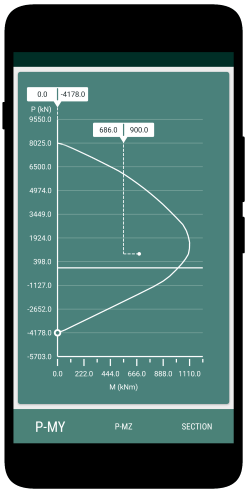Have you ever wondered why the columns in your building are so essential? Picture the skeleton of a human body, providing structure, support, and shape. In much the same way, columns and beams form the skeleton of a building, ensuring it stands tall and strong. Imagine waking up one morning to find cracks appearing on the walls or, a slight tilt in the structure. Such scenarios highlight the critical role that well-designed columns and beams play in maintaining the integrity and safety of any building.
Columns serve as fundamental structural elements in the construction industry, supporting vertical loads and transferring them to the building’s foundation. They provide stability, strength, and rigidity to the overall framework, with materials like concrete, steel, or wood. This is where the IS 456: 2000 comes into play, providing detailed guidelines for designing robust and reliable column sections.
In this blog, we delve into the of column design, exploring the steps involved in design of columns as per IS 456 : 2000. Our aim is to ensure the efficient performance of columns in diverse construction projects.
Computation of load on column
The load a column must support includes various forces from different structural elements.
$$ P_{u, floor} = P_{us} + P_{uw} + P_a $$
where, $ P_{us} $ = load transferred from slab to column at each floor level = $w_{us} \times A_{col}$
$ P_{uw} $ = wall load transferred to column at each floor level = $w_{uw} \times L_{w}$
$P_a$ = Load on column from above.
Calculation of moments in columns
Calculate the moment in the column using the following equations as per the conditions,
if a single beam is rigidly connected to column on one side,
$$M_e = \frac{w_u L^2}{12},$$
if two beams with unequal loads or unequal spans are rigidly connected on opposite sides of the column.
$$= (\frac{w_{u1} L_1^2}{12} – \frac{w_{u2} L_2^2}{12}), $$
if a single beam is simply in contact to column.
$$M_e = \frac{w_u L^2}{24},$$
if two beams with unequal loads or unequal spans are connected on opposite sides of the column
$$= (\frac{w_{u1} L_1^2}{24} – \frac{w_{u2} L_2^2}{24}),$$
Calculate the moment in column shall not be less then $ M_{ u.min} = P_u \times e_{ min}$, where $ e_{ min}$ is the min. eccentricity.
Determination of effective length of column
Effective length (leff) of column is a parameter which is related to the load carrying capacity of the column member. It is not necessary that effective length and the actual physical length of column will be equal in magnitude. The value of effective length varies as per the type of support of the column. As per IS 456: 2000, the effective length is related to the unsupported length by some factor.
Check this post to know more about effective length of column.
Take the effective length of the column approximately as follows :
- For top storey: $ L_{eff} = L$
- For intermediate storey: $ L_{eff} = 0.8 L $
- For bottom storey: $ L_{eff} = 0.8 L $
Determination of type of column
If $ L_{eff}/h < 12$, the column is short else it is slender or long. where, h = either b or D of the column. To begin with, it is necessary to decide whether the column will be short or long. This depends upon the slenderness ratio. Normally, effective lengths of columns are equal in two orthogonal planes.
Preliminary design
- Allowance for Moment: Increment the axial load on the column of each storey by an allowance as per IS 456: 2000, to account for the effect of bending moment due to fixity between beams and column. Apply this allowance to the load of corresponding floor under consideration and not to the total load, including the load from above.
- Allowance for Slenderness : If the column is slender, we use an allowance for reduction in load – carrying capacity due to the slenderness effect. Approximate the allowance corresponding to stress reduction coefficient $C_r$ in working stress method. $$ \% \text { allowance }=\left(1 / C_r-1\right) \times 100 \quad \text { where, } C_r=1.25-\frac{L_{\text {eff }} / b}{48} $$ . We have to increment the total axial load on a column by a $\%$ allowance value to account for the slenderness effect.
- Calculation of Total Equivalent Axial Design Load : $ P_{u.eq } = \text{axial load on column} + \text{allowance for fixity} + \text{allowance for slenderness}$
Design of axially loaded short columns
In practice this is done by use of available ready made design tables (SP-16). Students or beginners can themselves prepare such tables for their design using the following formulae.
- Assume $\%$ of steel (p between 1% to 3%). Required $A_g=\left(P_u / \lambda\right) /\left[0.4 f_{c k}+\left(0.67 f_y-0.4 f_{c k}\right) p_c\right]$ where,$p_c=A_{s c} / A_g$
- From assumed width $b$, obtain depth $D = A_g/b $.
- Calculate now $ A_{sc} $ for values of b and D using the formula : $$ A_{s c}=\left(P_u / \lambda-0.4 f_{c k} b D\right) /\left(0.67 f_y-0.4 f_{c k}\right)$$.
- Select appropriate Number – Diameter combination of bars.
- Assume dia. of lateral ties ($\phi_{tr}$), not less than 5mm or 1/4th the dia. ($\phi$) of main bar whichever is greater). Normally, 6mm dia. ties are used for main bar dia. less than 25mm. Decide the pitch s of ties such thats is not greater than least of (16$\phi$, 300mm and the least lateral dim. i.e. width b.)
Design procedure of short column with axial compression and uniaxial bending will be discussed in this post., whereas this post deals with axial compression and biaxial bending.
Conclusions
Designing column sections according to IS 456:2000 involves a systematic approach that ensures the structural integrity and safety of buildings. By following the steps outlined in this blog post, engineers can effectively determine the dimensions and reinforcement requirements for column sections. It is important to consult the latest version of the relevant design codes and seek guidance from experienced professionals to ensure accurate and reliable designs.
Some of the key learnings are as follows:
- Understanding the loads and moments: Determining the factored loads and moments acting on the column is crucial for understanding the forces it will experience.
- Analysis for section selection: Analyzing the column for axial load and bending moments helps in selecting an appropriate section.
- Evaluating effective length: The effective length of the column should be determined considering end conditions and factors like slenderness ratio to assess stability and buckling behavior.
- Calculating reinforcement requirements: Calculating the required steel, considering allowable stresses, cover, and spacing, ensures the column can resist forces.
Column design
- RCC Column Design is a free app for designing reinforced concrete columns as per Indian Standards.
- RCC Design and detailing could be performed for uniaxial and biaxial bending conditions specified in IS456:2000
- Option to save the design projects in local storage.
- Detailed calculation steps presented for verification and validation.

This article was crafted by a group of experts at eigenplus to ensure it adheres to our strict quality standards. The individuals who contributed to this article are:
Author


